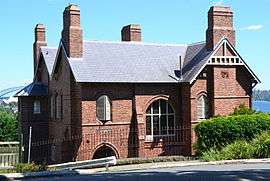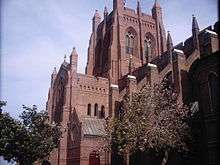John Horbury Hunt
John Horbury Hunt (1838 – December 30, 1904) was a Canadian-born Australian architect who worked in Sydney and rural New South Wales from 1863.


Life and career
Born in Saint John, New Brunswick, the son of a builder,[1] Hunt was trained in Boston, Massachusetts but then migrated to Australia in 1863. He worked in Sydney with Edmund Blacket for seven years prior to pursuing his own practice. His output was extremely varied and included cathedrals, churches, chapels, houses, homesteads, stables and schools. Probably his first building designed in Australia was the Superintendent's Residence at the Prince of Wales Hospital, Randwick, designed in 1863. A few years later he designed the Catherine Hayes Hospital, which was also built at the Prince of Wales Hospital, with the design modified by Thomas Rowe. Hunt's other works include the Convent of the Sacred Heart, now Kincoppal-Rose Bay, School of the Sacred Heart, Sydney, in the Sydney suburb of Vaucluse; and Tivoli, now part of Kambala, in the suburb of Rose Bay. In Armidale, New South Wales, he designed St Peter's Anglican Cathedral and Booloominbah and Trevenna which are now both part of the University of New England.
Hunt's distinctive, radical architecture was considered to be twenty years in advance of his peers, some of it unequalled in the world at that time, and sowed the seeds of some aspects of modern architecture in Australia. It has been said that "Undoubtedly men such as Hunt... have, through their buildings and their ideas, stiffened the intellectual backbone of Australian architecture."[2] He was instrumental in bringing the North American Shingle Style to Australia. The outstanding example of this style was Highlands, a two-storey home designed by Hunt and built for Alfred Hordern in 1891. Situated in Highlands Avenue, Wahroonga, Sydney, Highlands is listed on the Register of the National Estate.[3] Another notable example is Pibrac, designed by Hunt for Frederick Ecclestone du Faur. Pibrac is also on the Register of the National Estate.[4]
Hunt was ruined by the Depression of the 1890s. He died in Royal Prince Alfred Hospital, Camperdown, eleven days after admission suffering from Bright's disease (a kidney disease). His personal effects, recorded in the hospital Admission Book, consisted of a metal box, three gold rings, a silver pencil and a pair of spectacles. He was buried at South Head Cemetery, Vaucluse, Sydney (the story that he was buried in a tomb with his wife and pet pony is a popular myth).
He was close to destitute at the time of his death. His home, Cranbrook Cottage, had been repossessed by the mortgagor; it was demolished in 1925 to make room for the widening of New South Head Road. The site of the cottage is marked by a small rock garden, named Horbury Hunt Place. Riversdale House in Burradoo, now part of Chevalier College, still survives and is thought to be similar in design to Cranbrook Cottage, having been commissioned by Henry Osborne around the same period (c1875).[5]
Partial list of works
The following buildings designed either in part or in full by Hunt are listed on various national, state and local government heritage registers:
| Building name | Location | Year completed |
Australian National Heritage List |
NSW State Heritage Register |
Local government register |
Notes |
|---|---|---|---|---|---|---|
| All Saints Church | Hunters Hill, Sydney | 1885 | ||||
| Belltrees (shearing shed) | Scone | 1907 | ||||
| Booloominbah | University of New England, Armidale | 1883 | Yes | [6][7][8][9] | ||
| Camelot | Kirkham | 1888 | [10][11][12][13][14] | |||
| Catherine Hayes Building | Prince of Wales Hospital, Randwick | 1867 | completed by Thomas Rowe | |||
| Cloncorrick | Darling Point, Sydney | 1884 | [15][16] | |||
| Christ Church Cathedral and Church Hall | Grafton |
| ||||
| Christ Church Cathedral | Newcastle | 1869 | ||||
| Church of St James | Jerrys Plains | 1875 | ||||
| Church of the Good Shepherd and Rectory | Kangaroo Valley |
| ||||
| Cranbrook School, Sydney additions | Bellevue Hill, Sydney | 1874–75 | ||||
| Fairwater | Double Bay, Sydney | 1881 | Yes | [17] | ||
| Havilah homestead | Hunter Valley | |||||
| Havilah property extensions | Mudgee area | 1890 | ||||
| Highlands | Wahroonga, Sydney | 1891 | ||||
| Osborne Memorial Church of St Luke | Dapto | 1882 | ||||
| Pibrac | Warrawee, Sydney | 1888 | ||||
| Public School | Rozelle, Sydney | 1877 | ||||
| Public School and Headmaster's Residence | Frederickton | 1880 | ||||
| Riversdale House at Chevalier College | Burradoo | designed by Hunt.[18] | ||||
| Sacred Heart Convent, (now part of Kincoppal School) | Vaucluse, Sydney | 1888 | ||||
| Sir John Robertson Memorial | South Head Cemetery, Sydney | |||||
| St Alban's Anglican Church | Muswellbrook | 1869 | Yes | [19] | ||
| St Bartholomew’s Church of England, Ollera Station | Guyra | 1876 | ||||
| St James' Anglican Church | Morpeth | partly designed by Hunt.[20] | ||||
| St Matthias Church | Denman | 1871 | ||||
| St Paul's Church of England | Murrurundi | 1872 | ||||
| St Peter's Anglican Cathedral Church | Armidale | 1871 | [21] | |||
| Superintendent's Cottage, Prince of Wales Hospital | Randwick, Sydney | 1863 |
Gallery
 Sacred Heart Convent, c. 1930s, Vaucluse, New South Wales
Sacred Heart Convent, c. 1930s, Vaucluse, New South Wales Cloncorrick, Darling Point, New South Wales
Cloncorrick, Darling Point, New South Wales- Highlands, Wahroonga, New South Wales
- All Saints Church, Hunters Hill, New South Wales
 Christ Church Cathedral, Newcastle, New South Wales
Christ Church Cathedral, Newcastle, New South WalesPibrac_in_Warrawee.jpg) Pibrac, Warrawee, New South Wales
Pibrac, Warrawee, New South Wales- Public School, Rozelle, New South Wales
.jpg) Superintendent's Cottage, Prince of Wales Hospital, Randwick, New South Wales
Superintendent's Cottage, Prince of Wales Hospital, Randwick, New South Wales Catherine Hayes Building, Prince of Wales Hospital, Randwick, New South Wales
Catherine Hayes Building, Prince of Wales Hospital, Randwick, New South Wales- Sir John Robertson Memorial, South Head Cemetery, Vaucluse, New South Wales
 Church of the Good Shepherd, Kangaroo Valley, New South Wales
Church of the Good Shepherd, Kangaroo Valley, New South Wales
References
- Dictionary of Australian Biography
- A Pictorial Guide to Identifying Australian Architecture, Apperly (Angus and Robertson) 1994, p.17
- The Heritage of Australia, Macmillan Company, 1981, p.2/26
- The Heritage of Australia, p.2/33
- Wingecarribee Heritage Survey 1991 prepared by JRC Planning Services for the NSW Dept of Planning and Wingecarribee Shire Council
- "Booloominbah". New South Wales State Heritage Register. Office of Environment and Heritage. Retrieved 1 December 2017.
- "Booloominbah (Place ID 287)". Australian Heritage Database. Department of the Environment. 21 March 1978. Retrieved 1 December 2017.
- "Booloominbah Lodge (Place ID 13919)". Australian Heritage Database. Department of the Environment. Retrieved 1 December 2017.
- "Booloominbah Sub Lodge (Place ID 13920)". Australian Heritage Database. Department of the Environment. Retrieved 1 December 2017.
- "Camelot". New South Wales State Heritage Register. Office of Environment and Heritage. Retrieved 1 December 2017.
- "Camelot (Mansion, Gardener's Lodge, Stable, Gardens, Grounds, Trees)". New South Wales State Heritage Register. Office of Environment and Heritage. Retrieved 1 December 2017.
- "Camelot, Kirkham La, Kirkham, NSW, Australia (Place ID 3236)". Australian Heritage Database. Department of the Environment. 21 March 1978. Retrieved 1 December 2017.
- "Camelot Gardeners Lodge, Kirkham La, Kirkham, NSW, Australia (Place ID 3237)". Australian Heritage Database. Department of the Environment. 21 March 1978. Retrieved 1 December 2017.
- "Camelot Stables, Kirkham La, Kirkham, NSW, Australia (Place ID 3238)". Australian Heritage Database. Department of the Environment. Retrieved 1 December 2017.
- "Cloncorrick - house, street fencing". New South Wales State Heritage Register. Office of Environment and Heritage. Retrieved 1 December 2017.
- "Cloncorrick, 1 Annandale St, Darling Point, NSW, Australia (Place ID 2480)". Australian Heritage Database. Department of the Environment. 21 March 1978. Retrieved 1 December 2017.
- "Fairwater". New South Wales State Heritage Register. Office of Environment and Heritage. H01381. Retrieved 2 June 2018.
- "Chevalier College". New South Wales State Heritage Register. Office of Environment and Heritage.
- "St. Alban's Anglican Church". New South Wales State Heritage Register. Office of Environment and Heritage. H00458. Retrieved 1 June 2018.
- State Heritage Site
- Armidale Dumaresq Local Environmental Plan, 2008
- John Horbury Hunt: Radical Architect 1838–1904, author: Peter Reynolds, Historic Houses Trust Of New Sou, 2008. Paperback.
- Architect Extraordinary – the Life and Work of John Horbury Hunt: 1838–1904, author: J. M. Freeland, Cassell, Melbourne, 1970. Hard Cover.
External links
| Wikimedia Commons has media related to John Horbury Hunt. |